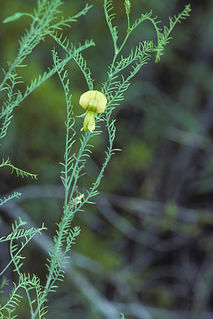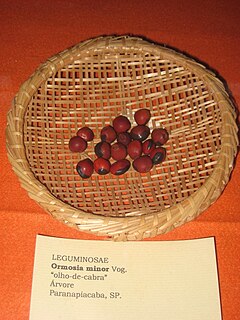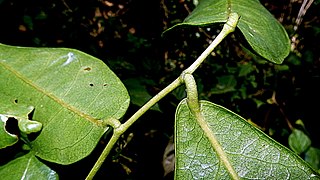
Dalbergia is a large genus of small to medium-size trees, shrubs and lianas in the pea family, Fabaceae, subfamily Faboideae. It was recently assigned to the informal monophyletic Dalbergia clade : the Dalbergieae. The genus has a wide distribution, native to the tropical regions of Central and South America, Africa, Madagascar and southern Asia.

Styphnolobium is a small genus of three or four species of small trees and shrubs in the subfamily Faboideae of the pea family Fabaceae, formerly included within a broader interpretation of the genus Sophora. It was recently assigned to the unranked, monophyletic Cladrastis clade. They differ from the genus Calia (mescalbeans) in having deciduous leaves and flowers in axillary, not terminal, racemes. The leaves are pinnate, with 9–21 leaflets, and the flowers in pendulous racemes similar to those of the black locust. Necklacepod is a common name for plants in this genus.

Iresine is a genus of flowering plants in the family Amaranthaceae. It contains 20 to 25 species, all of which are native to the American tropics. The generic name is derived from the Greek word εριος (erios), meaning "wooly", referring to the trichome-covered flowers. Bloodleaf is a common name for those species that have colored foliage, and these are often cultivated as ornamental plants. Some species are additives to versions of the hallucinogenic drink ayahuasca.

Cladrastis (yellowwood) is a genus of nine species of flowering plants in the family Fabaceae, eight native to eastern Asia, and one to southeastern North America.

Brongniartia is a genus of leguminous plants, first named by Kunth after the French botanist Adolphe Brongniart.

Centrolobium is a Neotropical genus of legume in the family Fabaceae, assigned to the informal monophyletic Pterocarpus clade of the Dalbergieae. The genus comprises mostly large trees to 30 m tall, characterised by an abundance of orange peltate glands that cover most parts of the plant, and fruits that are large winged samaras to 30 cm long with a spiny basal seed chamber.
Dussia is a genus of flowering plants in the family Fabaceae. It contains the following species:
Lecointea is a genus of flowering plants in the family Fabaceae. It contains the following species:

Lotononis is a genus of legumes in the family Fabaceae and the tribe Crotalarieae. Almost all of the species in the genus occur in southern Africa.

Machaerium is a genus of legume in the family Fabaceae, and was recently assigned to the informal monophyletic Dalbergia clade of the Dalbergieae. It contains the following species:

Myrocarpus is a genus of flowering plants in the family Fabaceae. It contains the following species:

Ormosia is a genus of legumes. The more than 100 living species, mostly trees or large shrubs, are distributed throughout the tropical regions of the world, some extending into temperate zones, especially in East Asia. A few species are threatened by habitat destruction, while the Hainan ormosia is probably extinct already.
Paramachaerium is a genus of legume in the family Fabaceae native to Amazonia. It was recently assigned to the informal monophyletic Pterocarpus clade within the Dalbergieae.

Platymiscium is a genus of legume in the family Fabaceae, and was recently assigned to the informal monophyletic Pterocarpus clade within the Dalbergieae. It has a Neotropical distribution, from northern Mexico to southern Brazil. Platymiscium is the only genus in the family with opposite leaves in all its species. Its wood has various uses, mostly for constructions and furniture.

Poecilanthe is a genus of legume in the family Fabaceae.

Aeschynomene is a genus of flowering plants in the family Fabaceae, and was recently assigned to the informal monophyletic Dalbergia clade of the Dalbergieae. They are known commonly as jointvetches. These legumes are most common in warm regions and many species are aquatic. The genus as currently circumscribed is paraphyletic and it has been suggested that the subgenus Ochopodium be elevated to a new genus within the Dalbergieae, though other changes will also be required to render the genus monophyletic.

Chaetocalyx is a genus of lianas in the legume family, Fabaceae. It belongs to the subfamily Faboideae, and was recently assigned to the informal monophyletic Adesmia clade of the Dalbergieae. Members of this genus are found in Central and South America. Chaetocalyx can be distinguished from most other legumes by its climbing habit, its imparipinnate leaves, and, in most species, by its elongate loments. It can be distinguished from Nissolia, which also has a climbing habit, by the articles of the loments, which are uniform in size in Chaetocalyx, rather than with a terminal, expanded, winglike article as in Nissolia. Unlike most papilionoid legumes, Chaetocalyx species do not form root nodules.
Myrospermum frutescens, the cercipo, is a species of flowering plant in the legume family, Fabaceae. It belongs to the subfamily Faboideae. It is the only member of the genus Myrospermum.
Spirotropis is a genus of flowering plants in the legume family, Fabaceae. It belongs to the subfamily Faboideae.
Sweetia fruticosa is a species of flowering plants in the legume family, Fabaceae and is the only member of the genus Sweetia. It belongs to the subfamily Faboideae. It was traditionally assigned to the tribe Sophoreae, mainly on the basis of flower morphology; recent molecular phylogenetic analyses assigned Sweetia fruticosa into an informal, monophyletic clade called the "vataireoids".














